How to Care for the Glorious Schefflera Amate
It’s hard not to love a plant with glossy eye-catching foliage and a stunning form; oh yes it is. I’ve grown plenty of the schefflera plants for years (there are quite a few of them on the market now) but this is my favorite. I want to share these Schefflera Amate care and growing tips so your home can have some wild and wonderful tropical vibes.
Most houseplants are native to the tropics or subtropics and the Amate is no different. What sets it apart and kicks it up a notch is the abundance of large leaves. I find this plant, commonly called an Umbrella Tree, easy to care for (even here in the Arizona desert where I live) and I think you will too.
Some Of Our General Houseplant Guides For Your Reference:
- 3 Ways To Successfully Fertilize Indoor Plants
- How to Clean Houseplants
- Winter Houseplant Care Guide
- Plant Humidity: How I Increase Humidity For Houseplants
- Buying Houseplants: 14 Tips For Indoor Gardening Newbies
- 11 Pet-Friendly Houseplants
Schefflera Amate Care and Growing Tips
I’ve done a previous post and video on Schefflera Amate care but that was a few years ago. Blogging style changes over the years, just like anything, and I wanted to do a more in depth care post on this fabulous plant I love for many reasons.
Form
The Schefflera Amate has a beautiful, rounded form. It’ll develop into a tree form as it ages but you can pinch it back to prevent that. It takes up a piece of real estate in your home because it grows a bit wider as it grows tall. If you’re tight on space, be sure to check up the Dracaena Lisa because it grows in a much more narrow form.
Size
This plant grows to around 10′. When grown outdoors, it can get taller. I bought mine in a 10″ pot which was around 4′ tall but I’ve also seen them in 6″, 8″ & 14″ pots.
Growth Rate
The Schefflera Amate grows moderate to fast indoors. Outdoors it grows fast.
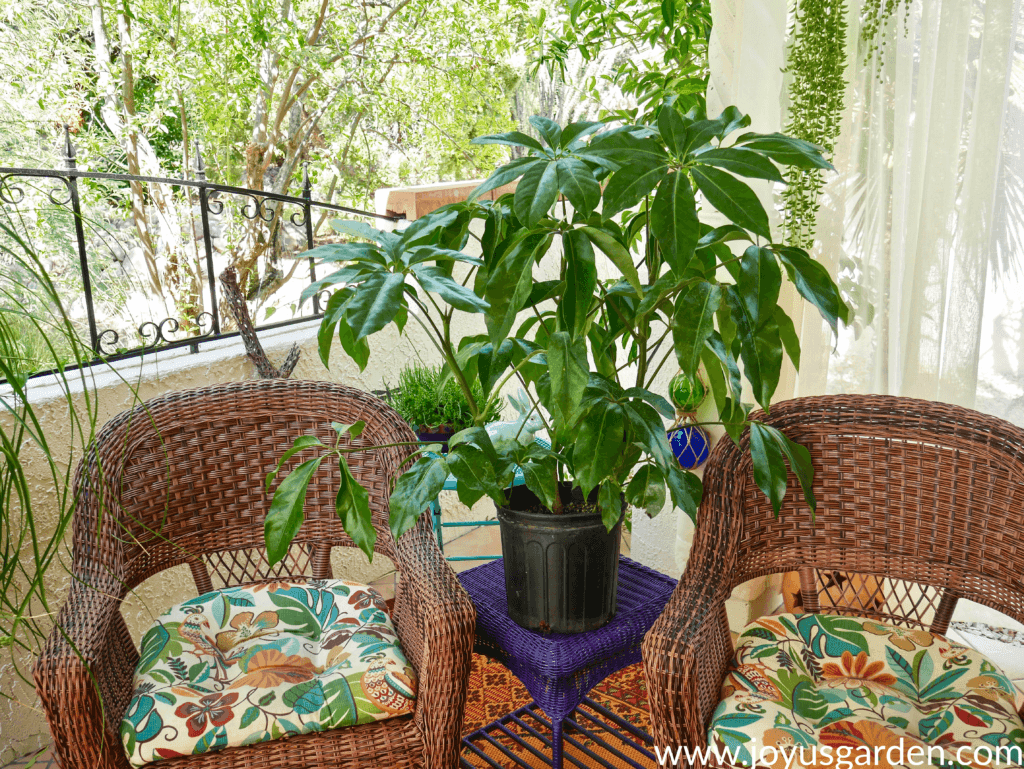
My Amate lookin’ good on the side patio for the filming. It’s in a 10″ pot now & I’ll transplant it into a 14″ one next spring.
Exposure
Medium light is best. For instance, mine sits in a north facing window where it gets natural light all day long. Remember, I live in Tucson AZ where we get A LOT of sun all year long. An east or south exposure might be better for yours depending on where you live.
High light is fine too as long as it’s not in or close to a hot, sunny window. It’ll tolerate lower light but just know it won’t grow as fast, the shape won’t be as good, & the leaves might droop a bit.
I rotate my plant every 3 months so it gets light on both sides. Otherwise, your Schefflera will start to lean towards the light source & grow in a 1-sided way. If you live in a climate where winters are darker, you may have to move your plant to a spot with stronger light for a few months.
Watering
Like most houseplants, this 1 doesn’t like to be kept consistently moist. Overwatering will lead to root rot & then leaf spot & perhaps powdery mildew. I water mine thoroughly every 7 days here in this hot climate. In winter I back it off to every 9-14 days depending on the weather.
If you have any questions on how often to water your houseplants, this post called houseplant watering 101 will help out.
Temperature
As I always say, if your home is comfortable for you, it’ll be so for your houseplants too. Just be sure to keep your Schefflera away from any cold drafts & air conditioning or heating vents.
It’ll take temps down to 30F when grown outdoors.
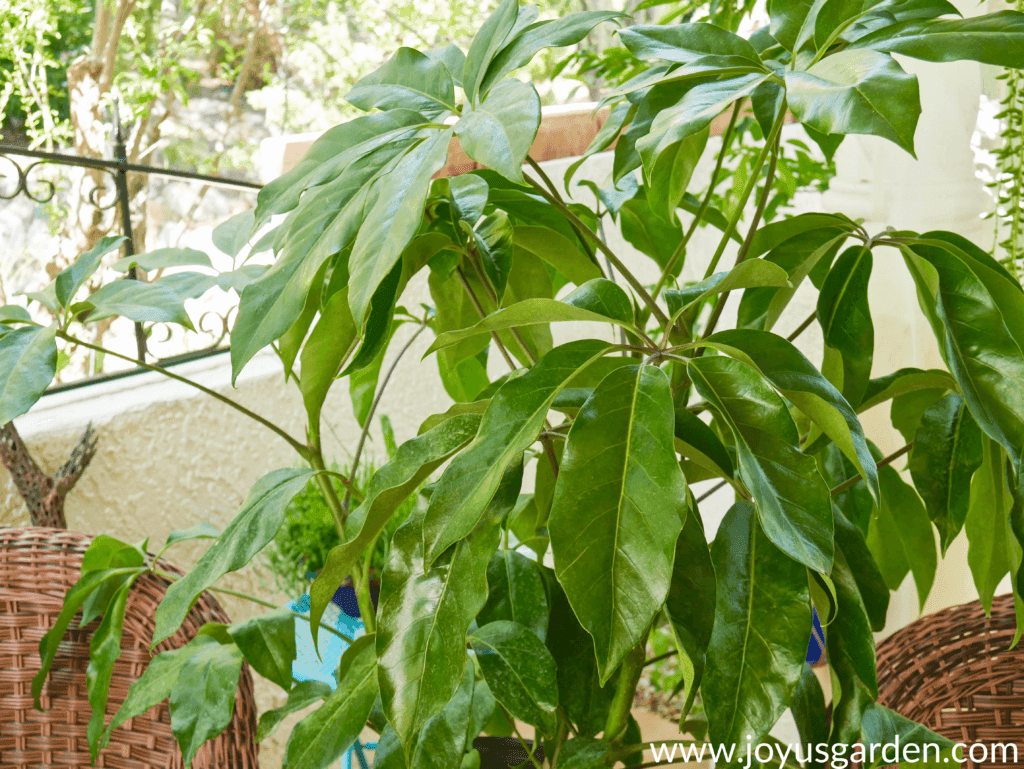
Oh, that fabulous foliage. And look Ma, no brown tips!
Humidity
Scheffleras are native to the subtropical & tropical rainforests. That being said, they do just fine in our homes which tend to have dry air. Here in hot dry Tucson, mine doesn’t have any brown tips at all which you can see in the pic above.
If you think yours looks stressed due to lack of humidity, fill the saucer with pebbles & water. Put the plant on the pebbles but make sure the drain holes &/or the bottom of the pot aren’t submerged in water. Misting a few times a week would also be appreciated.
Fertilizer
I don’t fertilize mine but that might change soon because I’m experimenting with a concoction. I’ll let you know. Right now I give my houseplants a light application of worm compost with a light layer of compost over that every spring. Easy does it – 1/4 to 1/2″ of each for a larger sized houseplant. Read about my worm compost/compost feeding right here.
Liquid kelp or fish emulsion would work fine too as well as a balanced liquid houseplant fertilizer (5-5-5 or lower) if you have that. Dilute any of these to half strength & apply in spring. If for some reason you think your Amate needs another application, do it again in summer.
You don’t want to fertilize houseplants in late fall or winter because that’s their time for rest. Don’t over fertilize your Schefflera Amate because salts build up & can burn the roots of the plant. Avoid fertilizing a houseplant which is stressed, ie. bone dry or soaking wet.
Soil
Any good quality preferably organic potting soil is fine. Just be sure it’s formulated for houseplants which it’ll say on the bag. I now use Smart Naturals by Fox Farm. It has lots of good stuff in it.
I always have coco coir on hand & add that in with the potting soil in a ratio of 1:3(ps). Growers love coco coir as a growing medium because it holds water well yet still provides good drainage & aeration. It’s much more environmentally friendly than peat moss which is considered to be a non-renewable resource but has all the same properties.
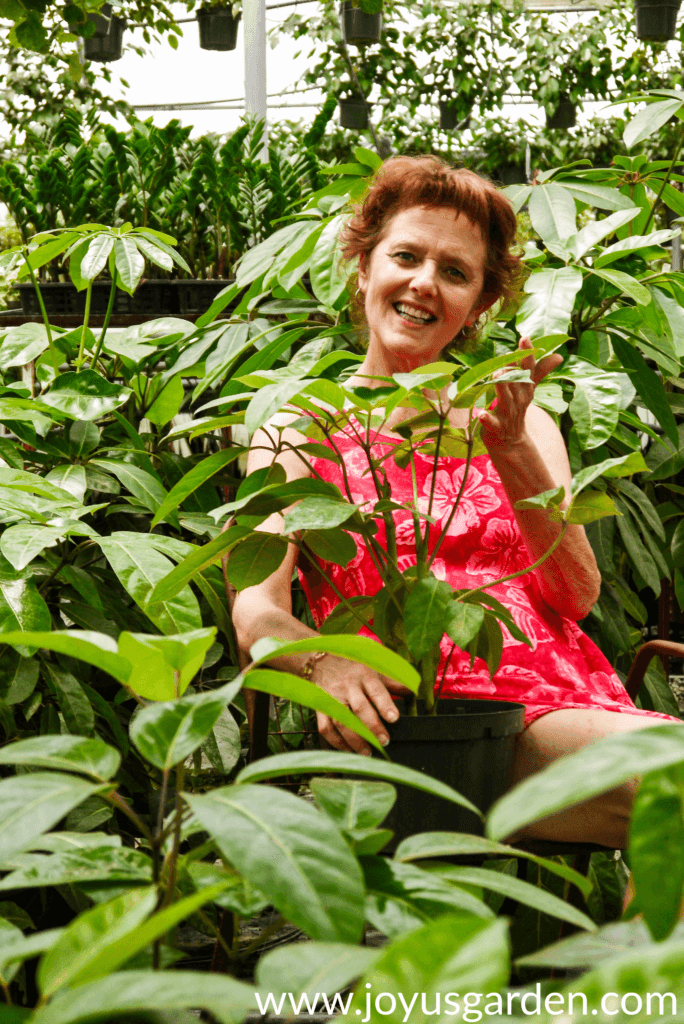
Me hanging out in the Amate forest at Santa Ynez Gardens, a wholesale nursery where we took most of the pics for our houseplant care book Keep Your Houseplants Alive.
Repotting / Transplanting
This is best done in spring or summer; early fall is fine if you’re in a warm climate. The faster your plant is growing, the sooner it’ll need repotting. I wouldn’t keep a Schefflera Amate too tight in its pot like some other houseplants.
I can see the fine roots in the drain holes of grow pot of mine. I’ll repot it in early spring into a 14″ pot. It’s in a 10″ pot now & I’ll skip the 12″ pot & go straight to 14″. You can do that with this plant.
Pruning
The main reasons to prune this plant are for propagation &/or to control the size. Mine grows in the bedroom where the ceilings are 9′ tall. I’ll tip prune it when my Schefflera is around 7 1/2′ to 8′ tall. I show you how I’ll do it in the video.
Just make sure your pruners are clean & sharp before you do any pruning.
Propagation
I imagine you can propagate this plant by tip cuttings (please let us know if you have) but I’ve never tried it.
The preferred method which has worked for me is air layering. I did this successfully on a Schefflera pueckleri or Tupidanthus which is a close relative of the Amate. I’m air layering 1 of my Ficus elasticas so that video & post will be coming up soon.
Just like transplanting, this is best done in spring or summer.
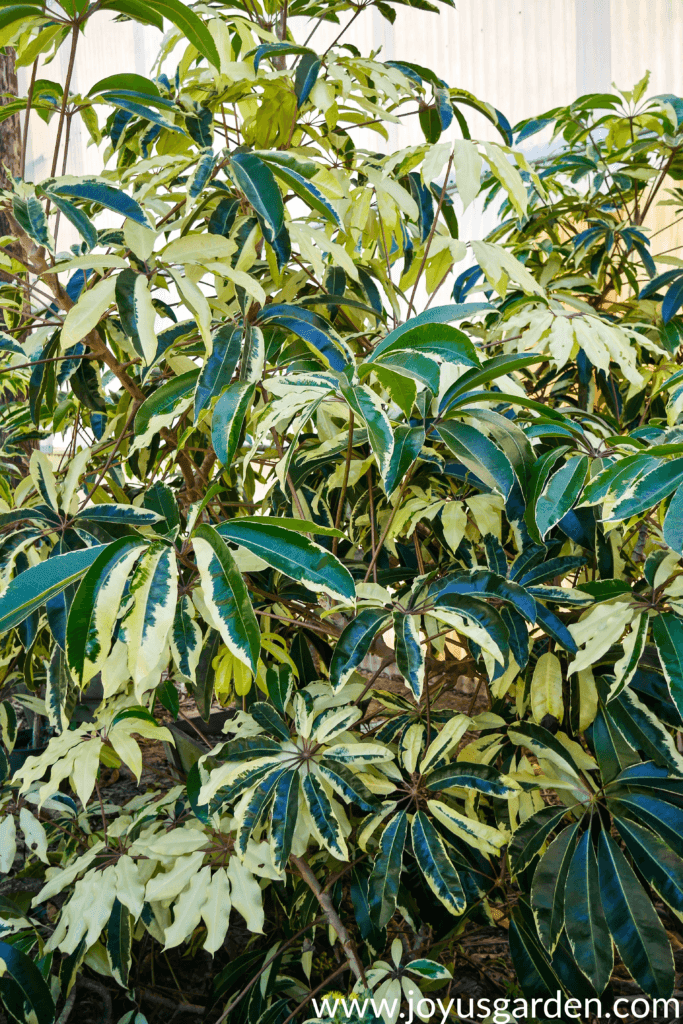
09 Here’s the variegated version of the schefflera I air layered. This is Schefflera pueckleri “variegata” or Variegated Tupidanthus. I haven’t seen this snazzy plant to often & wanted to share it with you.
Pests
Mine have never gotten any. When I was an interior plantscaper, all the Scheffleras were prone to spider mites, mealy bugs, scale & thrips. This was especially true when the heat came on in offices as the temps outdoors cooled.
The Amate has been bred to be more resistant to spider mites – more on that in “Good To Know. Click on the links above & you’ll be able to identify the pests & take action if need be.
Pets
There is nothing specific about the Amate & toxicity. Because other Scheffleras are considered to be toxic to dogs & cats, I’d make a bet this 1 is too. I always refer to the ASPCA website for this info & you can read about the effects this plant has on pets here.
Additional Tips for Growing Schefflera Amate Care
The Schefflera Amate is a selection of the OG Schefflera actinophylla. In a nutshell, the Amate is bred (via tissue culture not seed) to be better than the original. The form is better, it has a stronger root system, & is more resistant to spider mites & leaf spot. Head’s up – it’s more resistant to spider mites but not immune. Check your plant every now & then to make sure it hasn’t be invaded.
This plant needs room to spread out & be its gorgeous self. If you’re tight on space, look for another houseplant.
The Amate tolerates lower light conditions but does much better & looks much better in medium light.
Don’t over water your Schefflera Amate. It could bring on the dreaded leaf spot.
A leaf or 2 falling off every now & then is normal. That being said, green leaves falling off is due to the light conditions being too low.
Leaves spotted with or falling off black/dark brown is due to too much water.
Yellow leaves can be due to quite a few causes. The most common are: too dry, too wet or spider mites.
Don’t be tempted to use any commercial leaf shines to make those glossy leaves even glossier. You don’t want to clog the pores because the leaves need to breathe. I use a damp soft cloth to clean my houseplants with large leaves.
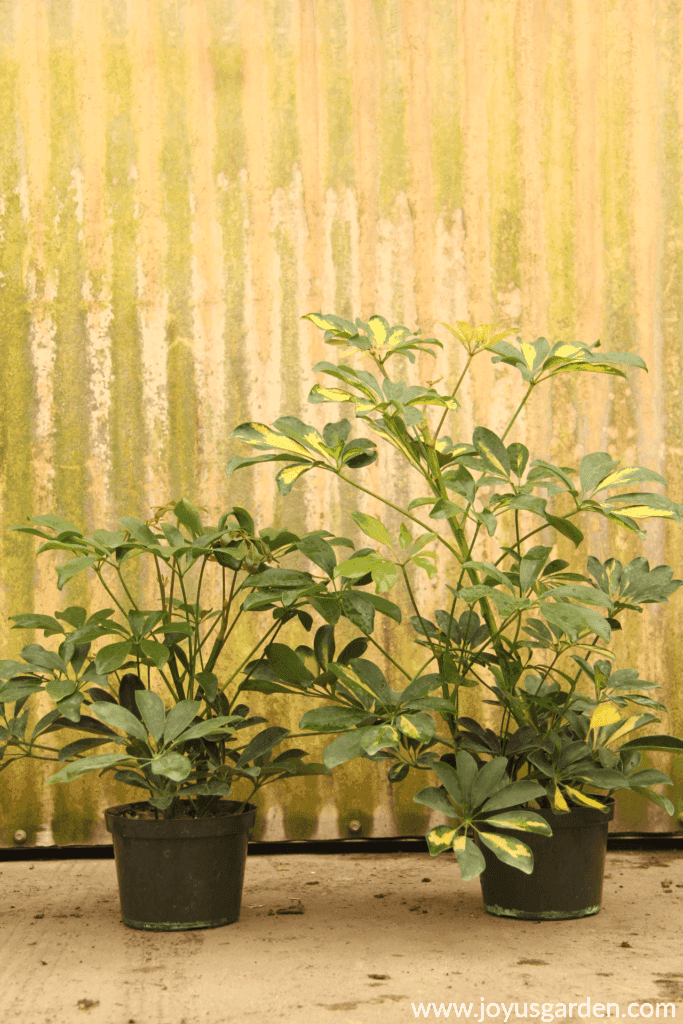
I really like Schefflera Amates and fortunately for you, they’re pretty easy to find.
Happy gardening,

YOU MAY ALSO ENJOY:

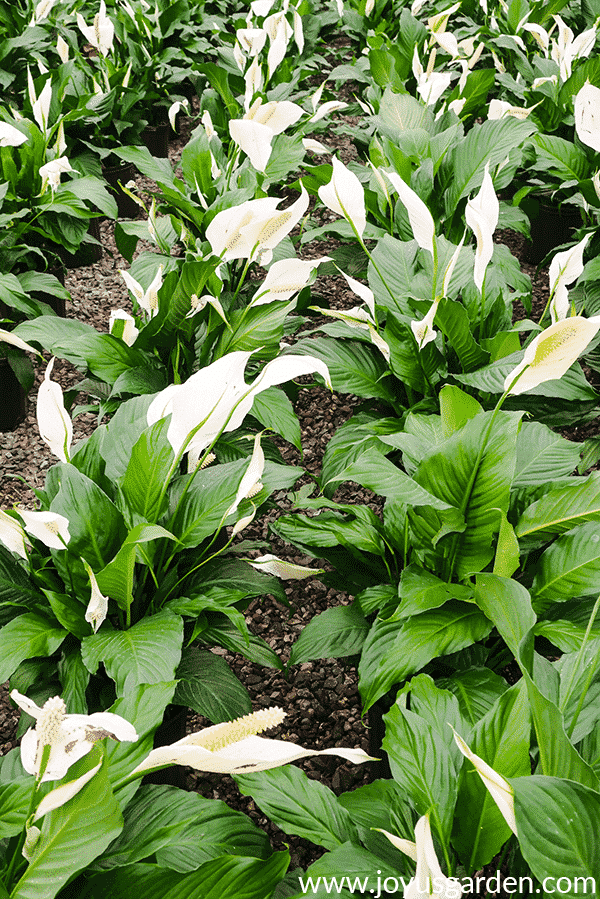
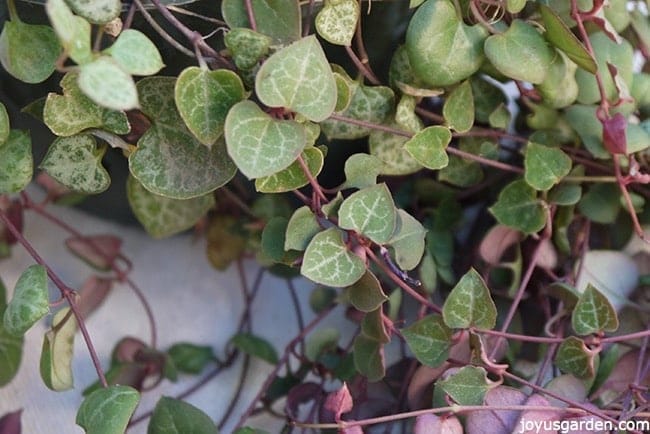
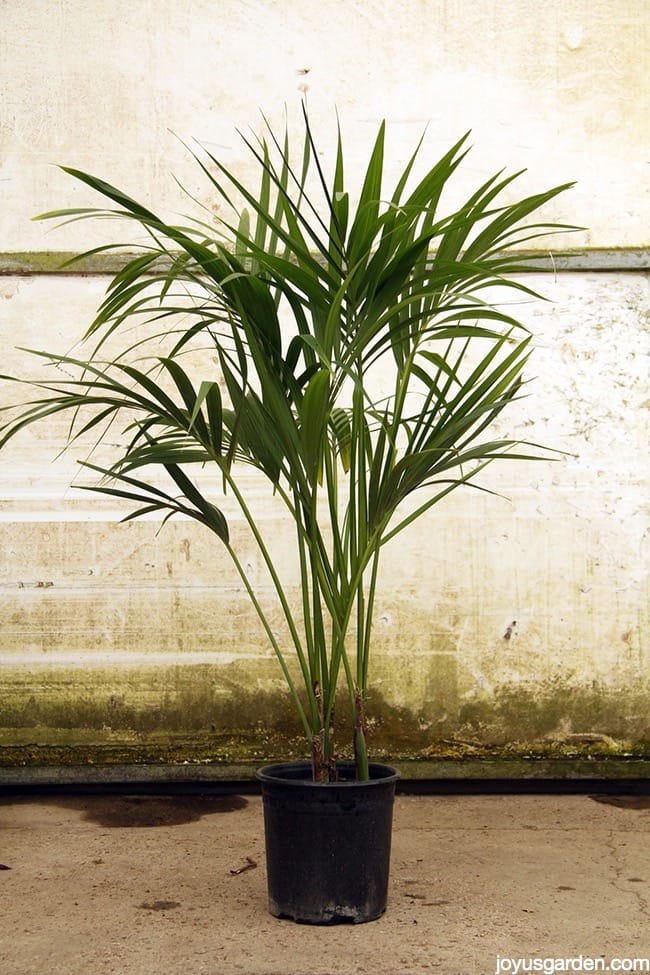
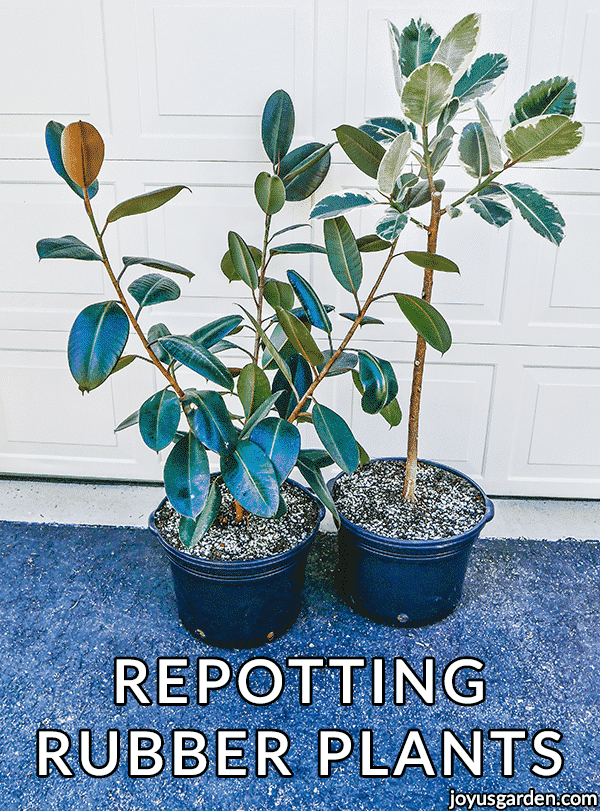

I enjoy your posts. I am confused about the name of this plant. You say it is a selection of Schefflera actinophylla. If this is true why isn’t it written as Schefflera actinophylla ‘Amate’? It is written everywhere as if “Amate” were a capitalized species name, Schefflera Amate. Is this correct? Please tell me why this is an exception.